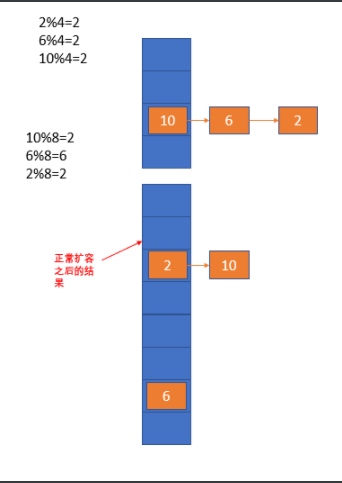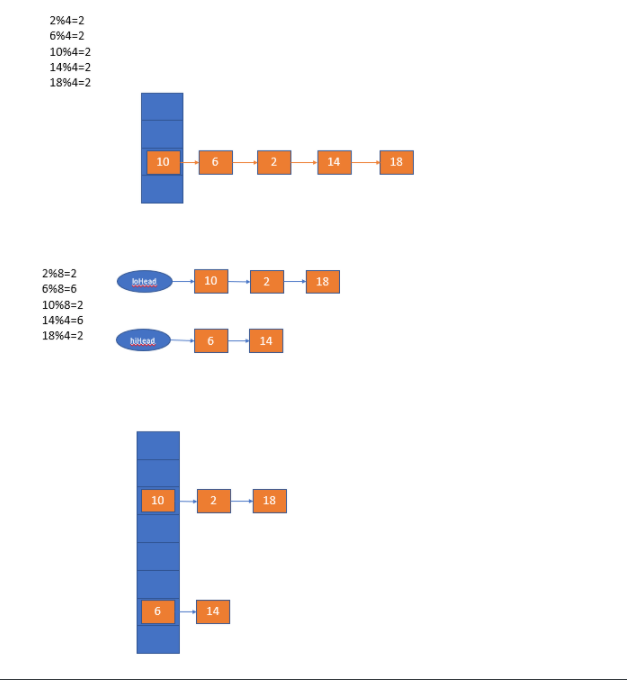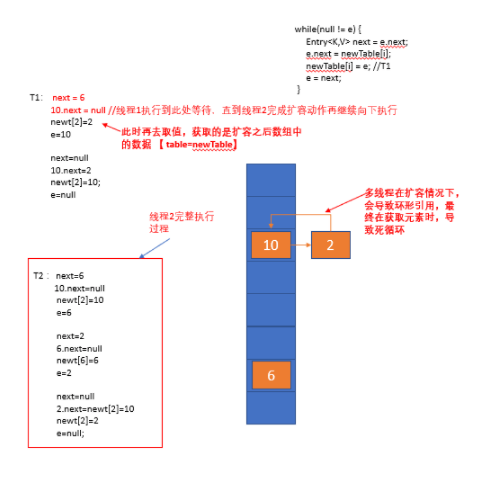# HashMap源码分析
# 1、HashMap存取值的原理
# 1、存值分析:
- jdk1.7存值分析
public V put(K key, V value) {
//HashMap允许存储null键,存储在数组的0索引位置
if (key == null)
return putForNullKey(value);
//内部通过一个扰乱算法获得一个hash值,用于计算数组索引
int hash = hash(key);
//计算数组索引
int i = indexFor(hash, table.length);
//判断是否是重复键
for (Entry<K,V> e = table[i]; e != null; e = e.next) {
Object k;
if (e.hash == hash && ((k = e.key) == key || key.equals(k))) {
V oldValue = e.value;
e.value = value;
e.recordAccess(this);
return oldValue;
}
}
modCount++;
//添加元素
addEntry(hash, key, value, i);
return null;
}
void addEntry(int hash, K key, V value, int bucketIndex) {
//元素个数大于阈值,同时当前索引位有值,就会执行扩容操作
if ((size >= threshold) && (null != table[bucketIndex])) {
//2倍扩容
resize(2 * table.length);
hash = (null != key) ? hash(key) : 0;
//重新计算索引位置
bucketIndex = indexFor(hash, table.length);
}
//基于键值创建Entry节点,并以头插法存入对应位置
createEntry(hash, key, value, bucketIndex);
}
- jdk1.8存值分析
public V put(K key, V value) {
//hash(key)计算hash值,用于计算索引
return putVal(hash(key), key, value, false, true);
}
final V putVal(int hash, K key, V value, boolean onlyIfAbsent,
boolean evict) {
Node<K,V>[] tab; Node<K,V> p; int n, i;
//完成初始化容器
if ((tab = table) == null || (n = tab.length) == 0)
n = (tab = resize()).length;
//得到的索引位没有元素,直接存入
if ((p = tab[i = (n - 1) & hash]) == null)
tab[i] = newNode(hash, key, value, null);
else {
//索引位有元素
Node<K,V> e; K k;
//重复键
if (p.hash == hash &&
((k = p.key) == key || (key != null && key.equals(k))))
e = p;
//红黑树节点
else if (p instanceof TreeNode)
//入树
e = ((TreeNode<K,V>)p).putTreeVal(this, tab, hash, key, value);
else {
//遍历链表依次比较键
for (int binCount = 0; ; ++binCount) {
//没有重复键
if ((e = p.next) == null) {
//尾插法,添加元素,形成单向链表
p.next = newNode(hash, key, value, null);
//树化
if (binCount >= TREEIFY_THRESHOLD - 1) // -1 for 1st
treeifyBin(tab, hash);
break;
}
//有重复键
if (e.hash == hash &&
((k = e.key) == key || (key != null && key.equals(k))))
break;
p = e;
}
}
if (e != null) { // existing mapping for key
V oldValue = e.value;
//键重复,更新值
if (!onlyIfAbsent || oldValue == null)
e.value = value;
afterNodeAccess(e);
return oldValue;
}
}
++modCount;
//容量超过阈值,扩容
if (++size > threshold)
resize();
afterNodeInsertion(evict);
return null;
}
# 2、取值分析
- jdk1.7取值
public V get(Object key) {
//取空键对应的值
if (key == null)
return getForNullKey();
//取非空键对应的值
Entry<K,V> entry = getEntry(key);
return null == entry ? null : entry.getValue();
}
final Entry<K,V> getEntry(Object key) {
int hash = (key == null) ? 0 : hash(key);
//遍历链表获取值
for (Entry<K,V> e = table[indexFor(hash, table.length)];
e != null;
e = e.next) {
Object k;
if (e.hash == hash &&
((k = e.key) == key || (key != null && key.equals(k))))
return e;
}
return null;
}
- jdk1.8取值分析
public V get(Object key) {
Node<K,V> e;
return (e = getNode(hash(key), key)) == null ? null : e.value;
}
final Node<K,V> getNode(int hash, Object key) {
Node<K,V>[] tab; Node<K,V> first, e; int n; K k;
if ((tab = table) != null && (n = tab.length) > 0 &&
(first = tab[(n - 1) & hash]) != null) {
//检查头部元素是否是要找的元素
if (first.hash == hash && // always check first node
((k = first.key) == key || (key != null && key.equals(k))))
return first;
if ((e = first.next) != null) {
//红黑树查找
if (first instanceof TreeNode)
return ((TreeNode<K,V>)first).getTreeNode(hash, key);
do {
//链表查找
if (e.hash == hash &&
((k = e.key) == key || (key != null && key.equals(k))))
return e;
} while ((e = e.next) != null);
}
}
return null;
}
# 2、HashMap如何防止碰撞
解决hash碰撞的方式有很多,比如开放地址法,重哈希,链地址法,公共溢出区等等。
HashMap中防止碰撞的方式主要有两个:哈希值扰动+链地址法(当扰动后,还是hash碰撞,使用链表/红黑树存储元素)
- jdk1.7扰动
final int hash(Object k) {
int h = 0;
h ^= k.hashCode();
//充分利用高低位
h ^= (h >>> 20) ^ (h >>> 12);
return h ^ (h >>> 7) ^ (h >>> 4);
}
01100011 00001110 11000110 00011001
00000000 01101010 11001100 00011001
- jdk1.8扰动
static final int hash(Object key) {
int h;
//充分利用高低位
return (key == null) ? 0 : (h = key.hashCode()) ^ (h >>> 16);
}
# 3、HashMap容量取值问题
- jdk1.7默认容量
public HashMap() {
//默认容量16
this(DEFAULT_INITIAL_CAPACITY, DEFAULT_LOAD_FACTOR);
}
- jdk1.7自定义容量
public HashMap(int initialCapacity) {
this(initialCapacity, DEFAULT_LOAD_FACTOR);
}
public HashMap(int initialCapacity, float loadFactor) {
if (initialCapacity < 0)
throw new IllegalArgumentException("Illegal initial capacity: " +
initialCapacity);
//超过最大容纳量,取最大容量
if (initialCapacity > MAXIMUM_CAPACITY)
initialCapacity = MAXIMUM_CAPACITY;
//负载因子容错处理
if (loadFactor <= 0 || Float.isNaN(loadFactor))
throw new IllegalArgumentException("Illegal load factor: " +
loadFactor);
//通过1左移运算,找到一个大于/等于自定义容量的最小2的幂次方数
int capacity = 1;
while (capacity < initialCapacity)
capacity <<= 1;
this.loadFactor = loadFactor;
threshold = (int)Math.min(capacity * loadFactor, MAXIMUM_CAPACITY + 1);
//基于容量,创建数组
table = new Entry[capacity];
useAltHashing = sun.misc.VM.isBooted() &&
(capacity >= Holder.ALTERNATIVE_HASHING_THRESHOLD);
init();
}
int capacity = 1;
while (capacity < initialCapacity)
capacity <<= 1;
例:
假设自定义容量取值为10
1<10
1进行左移运算
0000 0000 0000 0000 0000 0000 0000 0001 -- 新容量等于1
<<
0000 0000 0000 0000 0000 0000 0000 0010 -- 新容量等于2
2<10
2进行左移运算
0000 0000 0000 0000 0000 0000 0000 0010
<<
0000 0000 0000 0000 0000 0000 0000 0100 -- 新容量等于4
4<10
4进行左移运算
0000 0000 0000 0000 0000 0000 0000 0100
<<
0000 0000 0000 0000 0000 0000 0000 1000 -- 新容量等于8
8<10
8进行左移运算
0000 0000 0000 0000 0000 0000 0000 1000
<<
0000 0000 0000 0000 0000 0000 0001 0000 -- 新容量等于16
为什么容量必须是2的幂次方数呢?
① 以上那些2的幂次方数有一个特点,高位为1,后续全部为0,这样的数减一,就会变成刚才为1的位置为0,后续所有值都为1,这样减一之后的数,和任何数进行与运算,得到的结果,永远是0-2的幂次方减一,正好符合数组角标的范围。
② 同时减一后,一定是一个奇数,末位一定是1,那么和其他数进行与运算后,得到的结果可能是奇数,也可能是偶数,那么可以充分利用数组的容量。
③ 2的幂次方数减一后,低位都是1,这样数组的索引位都有可能存入元素,如果低位不都是1,就会导致有些数组的索引位永远空缺,不利于数组的充分利用
④ 便于扩容时,重新定位元素的索引位,我们知道扩容的原则是原来数组的2倍,那么扩容后,数组容量还是一个2的幂次方数,原数组中的元素在新数组中,要么在原始索引位,要么在原始索引位+扩容值的位置,避免了重新hash的效率问题
- jdk1.8容量赋值
注意,jdk1.8的容量计算动作,在resize()扩容方法中完成。
final Node<K,V>[] resize() {
Node<K,V>[] oldTab = table;
int oldCap = (oldTab == null) ? 0 : oldTab.length;
int oldThr = threshold;
int newCap, newThr = 0;
if (oldCap > 0) {
if (oldCap >= MAXIMUM_CAPACITY) {
threshold = Integer.MAX_VALUE;
return oldTab;
}
else if ((newCap = oldCap << 1) < MAXIMUM_CAPACITY &&
oldCap >= DEFAULT_INITIAL_CAPACITY)
newThr = oldThr << 1; // double threshold
}
else if (oldThr > 0) // initial capacity was placed in threshold
newCap = oldThr;
else { // zero initial threshold signifies using defaults
newCap = DEFAULT_INITIAL_CAPACITY;
newThr = (int)(DEFAULT_LOAD_FACTOR * DEFAULT_INITIAL_CAPACITY);
}
if (newThr == 0) {
float ft = (float)newCap * loadFactor;
newThr = (newCap < MAXIMUM_CAPACITY && ft < (float)MAXIMUM_CAPACITY ?
(int)ft : Integer.MAX_VALUE);
}
threshold = newThr;
@SuppressWarnings({"rawtypes","unchecked"})
Node<K,V>[] newTab = (Node<K,V>[])new Node[newCap];
table = newTab;
- jdk1.8中容量计算:
static final int tableSizeFor(int cap) {
int n = cap - 1;
n |= n >>> 1;
n |= n >>> 2;
n |= n >>> 4;
n |= n >>> 8;
n |= n >>> 16;
return (n < 0) ? 1 : (n >= MAXIMUM_CAPACITY) ? MAXIMUM_CAPACITY : n + 1;
}
int n = cap - 1;
n |= n >>> 1;
n |= n >>> 2;
n |= n >>> 4;
n |= n >>> 8;
n |= n >>> 16;
return (n < 0) ? 1 : (n >= MAXIMUM_CAPACITY) ? MAXIMUM_CAPACITY : n + 1;
假设初始容量设置为10:
n = 10-1
0000 0000 0000 0000 0000 0000 0000 1001 //9
n右移1位
0000 0000 0000 0000 0000 0000 0000 0100 //4
| 0000 0000 0000 0000 0000 0000 0000 1001 //9
-----------------------------------------------------
0000 0000 0000 0000 0000 0000 0000 1101 //13
n右移2位
0000 0000 0000 0000 0000 0000 0000 0011
| 0000 0000 0000 0000 0000 0000 0000 1101
---------------------------------------------------
0000 0000 0000 0000 0000 0000 0000 1111 //15
n右移4位
0000 0000 0000 0000 0000 0000 0000 0000
| 0000 0000 0000 0000 0000 0000 0000 1111
----------------------------------------------------
0000 0000 0000 0000 0000 0000 0000 1111 //15
通过一系列右移+或运算后,能够将初始值减一得到的值,后面的所有0变成1,最终返回的是得到的值+1的结果作为容量,正好就是大于等于给定容量的2的幂次方数
# 4、HashMap数据结构(1.7和1.8对比)
- jdk1.7数据结构:数组+单向链表
void createEntry(int hash, K key, V value, int bucketIndex) {
//取出索引位置的元素
Entry<K,V> e = table[bucketIndex];
//将新的元素放置到索引位,同时将原来的作为新元素的下一个保存,形成单向链表
//头插法
table[bucketIndex] = new Entry<>(hash, key, value, e);
size++;
}
- jdk1.8数据结构:数组+单向链表+红黑树+双向链表
数组和单向链表的结构,在这里就不再赘述了,前面存取元素的过程中已经分析
这里我们来看下红黑树和双向链表结构
//当添加元素后,单向链表长度达到8个会执行该方法
final void treeifyBin(Node<K,V>[] tab, int hash) {
int n, index; Node<K,V> e;
//如果此时数组长度小于64,会通过扩容数组的方式,来避免单向链表过长
if (tab == null || (n = tab.length) < MIN_TREEIFY_CAPACITY)
resize();
//通过转成红黑树,来避免单向链表过长
else if ((e = tab[index = (n - 1) & hash]) != null) {
TreeNode<K,V> hd = null, tl = null;
do {
//把所有Node节点,转成TreeNode节点,并形成双向链表
TreeNode<K,V> p = replacementTreeNode(e, null);
if (tl == null)
hd = p;
else {
p.prev = tl;
tl.next = p;
}
tl = p;
} while ((e = e.next) != null);
if ((tab[index] = hd) != null)
//将双向链表中的元素形成红黑树结构
hd.treeify(tab);
}
}
//当添加元素时,对应的索引位置为TreeNode节点,会执行该方法
final TreeNode<K,V> putTreeVal(HashMap<K,V> map, Node<K,V>[] tab,
int h, K k, V v) {
Class<?> kc = null;
boolean searched = false;
TreeNode<K,V> root = (parent != null) ? root() : this;
for (TreeNode<K,V> p = root;;) {
int dir, ph; K pk;
if ((ph = p.hash) > h)
dir = -1;
else if (ph < h)
dir = 1;
else if ((pk = p.key) == k || (k != null && k.equals(pk)))
return p;
else if ((kc == null &&
(kc = comparableClassFor(k)) == null) ||
(dir = compareComparables(kc, k, pk)) == 0) {
if (!searched) {
TreeNode<K,V> q, ch;
searched = true;
if (((ch = p.left) != null &&
(q = ch.find(h, k, kc)) != null) ||
((ch = p.right) != null &&
(q = ch.find(h, k, kc)) != null))
return q;
}
dir = tieBreakOrder(k, pk);
}
//以上逻辑,就是在遍历红黑树,决定新元素放置的位置
TreeNode<K,V> xp = p;
if ((p = (dir <= 0) ? p.left : p.right) == null) {
Node<K,V> xpn = xp.next;
TreeNode<K,V> x = map.newTreeNode(h, k, v, xpn);
//找到新元素放置的位置,并将其添加进红黑树结构
if (dir <= 0)
xp.left = x;
else
xp.right = x;
//同时维护双向链表结构
xp.next = x;
x.parent = x.prev = xp;
if (xpn != null)
((TreeNode<K,V>)xpn).prev = x;
//通过变色+旋转达到红黑树的自平衡
moveRootToFront(tab, balanceInsertion(root, x));
return null;
}
}
}
你可能会有疑问,为什么在维护红黑树的同时,需要再维护一种双向链表的结构呢?其实主要是为了扩容方便的
# 5、HashMap扩容时机及扩容机制
- jdk1.7扩容:先扩容,在添加值
void addEntry(int hash, K key, V value, int bucketIndex) {
//当元素个数达到了扩容阈值,同时元素该放置的位置有元素时,会执行扩容
if ((size >= threshold) && (null != table[bucketIndex])) {
//扩容为原来的两倍
resize(2 * table.length);
hash = (null != key) ? hash(key) : 0;
bucketIndex = indexFor(hash, table.length);
}
//扩容之后,在将新元素添加进集合
createEntry(hash, key, value, bucketIndex);
}
void resize(int newCapacity) {
Entry[] oldTable = table;
int oldCapacity = oldTable.length;
//达到最大容量,不扩容
if (oldCapacity == MAXIMUM_CAPACITY) {
threshold = Integer.MAX_VALUE;
return;
}
//根据新容量创建数组
Entry[] newTable = new Entry[newCapacity];
boolean oldAltHashing = useAltHashing;
useAltHashing |= sun.misc.VM.isBooted() &&
(newCapacity >= Holder.ALTERNATIVE_HASHING_THRESHOLD);
//计算是否需要重新计算hash
boolean rehash = oldAltHashing ^ useAltHashing;
//将旧数组中的元素迁移到新的数组中
transfer(newTable, rehash);
//保存新数组
table = newTable;
threshold = (int)Math.min(newCapacity * loadFactor, MAXIMUM_CAPACITY + 1);
}
void transfer(Entry[] newTable, boolean rehash) {
int newCapacity = newTable.length;
for (Entry<K,V> e : table) {
while(null != e) {
//记录遍历到的元素的下一个元素
Entry<K,V> next = e.next;
if (rehash) {
e.hash = null == e.key ? 0 : hash(e.key);
}
//计算新数组的角标位置
int i = indexFor(e.hash, newCapacity);
//把当前元素的下一个改为新数组对应位置的元素--头插法
e.next = newTable[i];
//将当前元素放置在数组对应索引位置
newTable[i] = e;
//再次迁移下一个元素
e = next;
}
}
}

- jdk1.8扩容:先添加值,再扩容
//元素个数,达到扩容阈值,就扩容
//这个方法前半部分初始化数组的逻辑之前已经分析过了
final Node<K,V>[] resize() {
Node<K,V>[] oldTab = table;
int oldCap = (oldTab == null) ? 0 : oldTab.length;
int oldThr = threshold;
int newCap, newThr = 0;
if (oldCap > 0) {
//数组容量达到最大值,不扩容
if (oldCap >= MAXIMUM_CAPACITY) {
threshold = Integer.MAX_VALUE;
return oldTab;
}
//新的数组容量为原来的2倍
else if ((newCap = oldCap << 1) < MAXIMUM_CAPACITY &&
oldCap >= DEFAULT_INITIAL_CAPACITY)
newThr = oldThr << 1; // double threshold
}
else if (oldThr > 0) // initial capacity was placed in threshold
newCap = oldThr;
else { // zero initial threshold signifies using defaults
newCap = DEFAULT_INITIAL_CAPACITY;
newThr = (int)(DEFAULT_LOAD_FACTOR * DEFAULT_INITIAL_CAPACITY);
}
if (newThr == 0) {
float ft = (float)newCap * loadFactor;
newThr = (newCap < MAXIMUM_CAPACITY && ft < (float)MAXIMUM_CAPACITY ?
(int)ft : Integer.MAX_VALUE);
}
threshold = newThr;
@SuppressWarnings({"rawtypes","unchecked"})
Node<K,V>[] newTab = (Node<K,V>[])new Node[newCap];
table = newTab;
if (oldTab != null) {
for (int j = 0; j < oldCap; ++j) {
Node<K,V> e;
if ((e = oldTab[j]) != null) {
oldTab[j] = null;
//数组角标位置只有一个元素,直接将数据迁移到新数组
if (e.next == null)
newTab[e.hash & (newCap - 1)] = e;
//数组角标位置为TreeNode,迁移红黑树数据
else if (e instanceof TreeNode)
((TreeNode<K,V>)e).split(this, newTab, j, oldCap);
else { // preserve order
//迁移单向链表数据
Node<K,V> loHead = null, loTail = null;
Node<K,V> hiHead = null, hiTail = null;
Node<K,V> next;
//先遍历整个单向链表,元素放置的位置,要么是原来的位置,要么是原来位置+扩容容量的位置
do {
next = e.next;
//放置在原来角标位置的元素
if ((e.hash & oldCap) == 0) {
if (loTail == null)
loHead = e;
else
//尾插法
loTail.next = e;
loTail = e;
}
//放置在原来角标+扩容容量 位置的元素
else {
if (hiTail == null)
hiHead = e;
else
//尾插法
hiTail.next = e;
hiTail = e;
}
} while ((e = next) != null);
//将放置在原角标位的元素存入数组
if (loTail != null) {
loTail.next = null;
newTab[j] = loHead;
}
//将放置在新角标位的元素存入数组
if (hiTail != null) {
hiTail.next = null;
newTab[j + oldCap] = hiHead;
}
}
}
}
}
return newTab;
}
红黑树数据的迁移
final void split(HashMap<K,V> map, Node<K,V>[] tab, int index, int bit) {
TreeNode<K,V> b = this;
// Relink into lo and hi lists, preserving order
TreeNode<K,V> loHead = null, loTail = null;
TreeNode<K,V> hiHead = null, hiTail = null;
int lc = 0, hc = 0;
//通过遍历双向链表,实现数据迁移
for (TreeNode<K,V> e = b, next; e != null; e = next) {
next = (TreeNode<K,V>)e.next;
e.next = null;
//原角标位置
if ((e.hash & bit) == 0) {
//记录前一个
if ((e.prev = loTail) == null)
loHead = e;
else
//记录下一个 -- 尾插法
loTail.next = e;
loTail = e;
//该标记累计,用于判断是否需要转会单向链表
++lc;
}
//原角标+扩容容量 位置
else {
//记录前一个
if ((e.prev = hiTail) == null)
hiHead = e;
else
//记录下一个 -- 尾插法
hiTail.next = e;
hiTail = e;
//该标记累计,用于判断是否需要转会单向链表
++hc;
}
}
if (loHead != null) {
//元素个数小于等于6,转成单向链表
if (lc <= UNTREEIFY_THRESHOLD)
tab[index] = loHead.untreeify(map);
else {
//存入新的数组
tab[index] = loHead;
if (hiHead != null) // (else is already treeified)
//树化
loHead.treeify(tab);
}
}
if (hiHead != null) {
//元素个数小于等于6,转成单向链表
if (hc <= UNTREEIFY_THRESHOLD)
tab[index + bit] = hiHead.untreeify(map);
else {
//存入新的数组
tab[index + bit] = hiHead;
if (loHead != null)
//树化
hiHead.treeify(tab);
}
}
}
//将红黑树转成单向链表
final Node<K,V> untreeify(HashMap<K,V> map) {
Node<K,V> hd = null, tl = null;
for (Node<K,V> q = this; q != null; q = q.next) {
Node<K,V> p = map.replacementNode(q, null);
if (tl == null)
hd = p;
else
//尾插法,形成单向链表
tl.next = p;
tl = p;
}
return hd;
}

# 6、多线程下HashMap扩容的问题(1.7和1.8对比)
- jdk1.7,多线程扩容情况下,会导致循环引用

- jdk1.8,多线程环境下,会导致数据丢失问题
// 添加元素时,会有数据覆盖丢失数据
final V putVal(int hash, K key, V value, boolean onlyIfAbsent,
boolean evict) {
Node<K,V>[] tab; Node<K,V> p; int n, i;
if ((tab = table) == null || (n = tab.length) == 0)
n = (tab = resize()).length;
//此处,如果多个线程向同一个位置存入元素,会有值覆盖的问题,导致数丢失
if ((p = tab[i = (n - 1) & hash]) == null)
tab[i] = newNode(hash, key, value, null);
//下面代码省略
// 扩容时,迁移数据的情况下,会有数据覆盖丢失的问题
// 多线程环境下,给同一个数组的相同位置赋值,会有数据覆盖的风险
if (loTail != null) {
loTail.next = null;
newTab[j] = loHead; //将原始索引位的数据迁移到新数组
}
if (hiTail != null) {
hiTail.next = null;
newTab[j + oldCap] = hiHead; //将新索引位的数据迁移到新数组
}
当然,jdk1.8中的HashMap本身是线程不安全的,在多线程环境下,应该还会有更多其他问题,有待大家一起去探究。
**位 与:都为1,才为1
10&5
00000000000000000000000000001010
& 00000000000000000000000000000101
---------------------------------------------
00000000000000000000000000000000
位 或:只要有个一个为1,就为1
10|5
00000000000000000000000000001010
| 00000000000000000000000000000101
---------------------------------------------
00000000000000000000000000001111 === 15
位 异或:两个数不一样,才为1
10^5
00000000000000000000000000001010
^ 00000000000000000000000000000101
--------------------------------------------
00000000000000000000000000001111 === 15
------------------------------------
哈希值
通过一定的散列算法,把一个不固定长度的输入,转成一个固定长度的输出,输出的结果我们称之为哈希
map中,hash就是一个int值
哈希表:存储哈希值的数组 -- 存取散列值(哈希值)的一个容器
哈希值到底该如何存,该如何取呢??? -- 通过数组的角标实现数据的存取
需要有一个映射:不同的hash值存在对应角标位
hash值 ----运算---》 index
哈希函数:将哈希值通过某种运算规则得到对应index
如何让存取效率是最高的??? -- 如果元素都是均匀存储在数据的角标位,而不产生冲突,就是最好的
① 尽可能少的产生hash冲突
hash函数计算出来的角标要尽可以能均匀
static int indexFor(int h, int length) {
return h & (length-1); //length是map中数组的长度
}
length长度的规则是什么?? -- 要求是2的幂次方数,为啥???
假设长度是8 -1 === 7
00000000000000000000000000000111 --- 长度8,参与hash运算是7
00000000000000000000000000001111 --- 长度16,参与hash运算是15
00000000000000000000000000011111 --- 长度32,参与hash运算是31
00110011000111111001110111101111
& 00000000000000000000000000001111
--------------------------------------------
00000000000000000000000000000000 -- 00000000000000000000000000001111
【得到的值,正好是0-15的范围,该范围正好是长度为16的数组的角标】
假设长度不是2的幂次方:
奇数 -- 长度5
00101001001001011111111111100111
& 00000000000000000000000000000100 -- 长度5,参与hash运算是4
------------------------------------------
得到的结果永远是一个偶数,代表获取的角标永远是偶数,奇数位的角标永远会都没有值
【数组的就浪费掉了一半】
偶数 -- 长度6
00101001001001011111111111100111
& 00000000000000000000000000000101 -- 长度6,参与hash运算是5
-------------------------------------------------
第二位永远是0,导致2,3角标位都不可能有值
【数组的就浪费掉了一半】
2的幂次方,在扩容时,扩容后的数组长度是原数组长度的2倍,结果还是2的幂次方
有啥好处???
假设原来是8
00000000000000000000000000000111
扩容后是16
00000000000000000000000000001111
在扩容时,数据要从原数组中迁移到新数组中
00000000000000000000000000001101
00000000000000000000000000000111
-------------------------------------
101 === 5 原数组的角标位
00000000000000000000000000001101
00000000000000000000000000001111
--------------------------------------
1101 ==== 13(原角标位+扩容长度) 新数组的角标位
【扩容后,数据迁移时,数据要么在原来位置,要么在原来位置+扩容长度
不需要重新hash--效率更好】
② 确实产生了hash冲突 -- 扩容+数据结构
扩容
什么时候扩容
jdk1.7
判断是否到达阈值(0.75*数组长度)
同时是否产生hash冲突
扩容后,再添加元素
jdk1.8
先添加元素
判断是否达到阈值
怎么扩容
jdk1.7
添加元素使用头插法
将单向链表的数据进行迁移
jdk1.8
添加元素使用尾插法
如果对应角标位是单向链表,将单向链表进行数据迁移
如果对应角标位是红黑树,将双向链表进行数据迁移
如果发现迁移完数据后,双向链表的结构小于/等于6,会将红黑树重新转回单向链表的结构
扩容后有什么问题(多线程环境)
jdk1.7
多线程环境下会形成环形链表
jdk1.8
多线程环境下会有数据丢失的问题
数据结构解决
jdk1.7产生冲突后,会形成单向链表
jdk1.8产生冲突后
会形成单向链表
如果单向链表的长度大于/等于8,会转成红黑树+双向链表(扩容时使用)